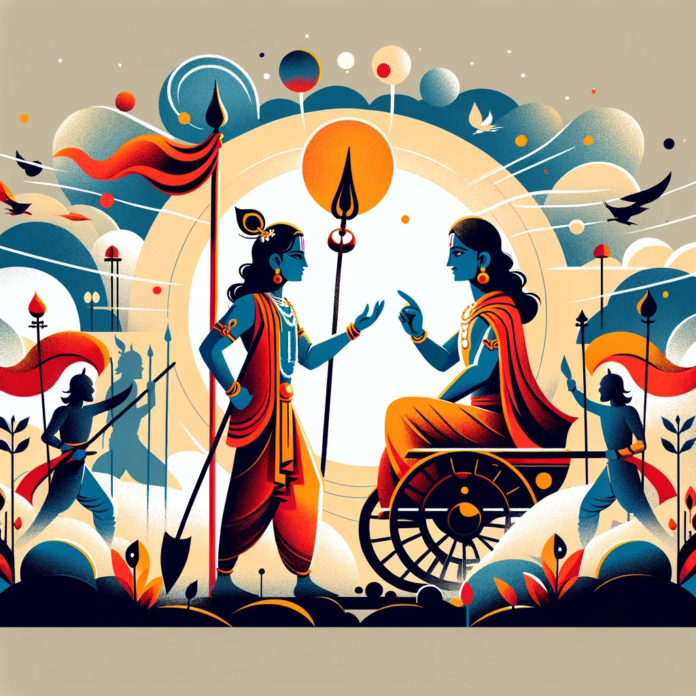“Geeta Jayanti” refers to the celebration of the Bhagavad Gita, a sacred Hindu scripture. The Bhagavad Gita, often referred to as the Gita, is a 700-verse Sanskrit scripture that is part of the Indian epic Mahabharata. It is a conversation between Prince Arjuna and the Bhagawan Krishna, who serves as his charioteer. Geetajayanti is typically celebrated on the day of Ekadashi of the bright half (Shukla Paksha) of the Margashirsha month (November–December) in the Hindu calendar. This day is considered auspicious for studying and reciting the verses of the Bhagavad Gita, reflecting on its teachings, and contemplating its spiritual significance.
Devotees and scholars often organise events, discussions, and readings of the Bhagavad Gita on Geetajayanti to promote a deeper understanding of its philosophical teachings. The Gita addresses important concepts such as duty (dharma), righteousness, the nature of the self (atman), and the path to spiritual realization.
Geetajayanti is an occasion for spiritual reflection and the pursuit of knowledge, emphasising the timeless wisdom contained in the Bhagavad Gita. The celebration varies in its customs and observances among different communities and regions.
Among Bhagavadgeeta’s various philosophical concepts, one of the most fundamental is the framework of the three Gunas—Sattva (goodness), Rajas (passion), and Tamas (ignorance). This essay explores the significance of these Gunas as outlined in the Bhagavad Gita, delving into specific verses that elucidate their nature and impact on human existence.
Sattva (Goodness):
Slokas Explaining Sattva:
The quality of Sattva is associated with purity, wisdom, and virtuous living. In Chapter 14, Verse 6, Lord Krishna provides insights into the nature of Sattva:
“Tatra sattvam nirmalatvat prakāśakam anāmayam
Sukhasaṅgena badhnāti jñānasaṅgena cānagha”
He says “O sinless one, the mode of goodness, being purer than the others, is illuminating, and it frees one from all sinful reactions. Those situated in that mode become conditioned by a sense of happiness and knowledge.” This verse emphasizes the purity and illuminating nature of Sattva. It suggests that individuals influenced by Sattva experience clarity and joy and are liberated from the repercussions of sinful actions. The association with happiness and knowledge implies that Sattva is conducive to spiritual growth and enlightenment.
Sattva promotes qualities such as compassion, self-discipline, and humility.
In Chapter 18, Verse 26, Lord Krishna further elaborates on the characteristics of individuals dominated by Sattva:
“Prītiṁ dānaṁ guṇeṣu na vidhīyate
Bhāva-janitaṁ yena tyajaṁti niṣṭhā”
He says “Charity given out of duty, without expectation of return, at the proper time and place, and to a worthy person, is considered to be in the mode of goodness.” This verse highlights the selfless and dutiful nature of actions performed in the mode of Sattva. Charity, when done without attachment and for the benefit of others, is a manifestation of goodness. It emphasizes the importance of performing actions with a sense of duty and without selfish motives.
Rajas (Passion):
Slokas Explaining Rajas: Rajas, the mode of passion, is associated with activity, desire, and ambition. In Chapter 14, Verse 7, Lord Krishna delineates the characteristics of Rajas:
“Rajo rāga-atmakam viddhi tr̥ṣṇā-saṅga-samudbhavam
Tan nibadhnāti kaunteya karma-saṅgena dehinam”
Bhagawan Krishna says “O son of Kunti, the mode of passion is born of unlimited desires and longings, and because of this, the embodied living entity is bound to material fruitive actions.”
This verse underlines the binding nature of actions motivated by passion. The insatiable desires and longings associated with Rajas lead individuals to be attached to the fruits of their actions. The consequence is a perpetual cycle of materialistic pursuits, which binds the individual to the material world.
In Chapter 14, Verse 12, Lord Krishna describes the consequences of Rajasic qualities:
“Lobhaḥ pravṛittiṁ cārāraṁbhaḥ karmaṇāmaśamaḥ spṛhā
Rajasa etāni jāyante vivṛddhe bharatarṣhabha”
“Greed, activity for self-satisfaction, excessive endeavor, dissatisfaction, and the tendency to perform actions without consideration are the symptoms of those possessing the quality of passion.” This verse provides a comprehensive insight into the manifestations of Rajasic qualities. Greed, restlessness, and a lack of discernment in actions are highlighted as characteristics that arise from the dominance of Rajas. It underscores the challenges posed by the passionate nature in the pursuit of spiritual growth.
Tamas (Ignorance):
Slokas Explaining Tamas:
Tamas, the mode of ignorance, is associated with inertia, delusion, and darkness. In Chapter 14, Verse 8, Lord Krishna elucidates the nature of Tamas:
“Tamas tv ajñāna-jaḿ viddhi mohanaḿ sarva-dehinām
Pramādālasyanidrābhis tan nidrātaḿ ca pauruṣaḿ”
“O son of Kunti, the mode of ignorance causes the delusion of all living entities. The result of this mode is madness, indolence, and sleep, which bind the conditioned soul.”
This verse emphasizes the obstructive nature of Tamas. Ignorance leads to delusion, madness, and a lack of awareness. The metaphor of sleep symbolizes spiritual unawareness and the slumbering state of consciousness. Individuals dominated by Tamas remain bound to material existence due to their lack of understanding and awareness.
In Chapter 14, Verse 13, Lord Krishna further expounds on the characteristics of Tamas:
“Aprakāśo’pravṛittiśca pramādo moha eva ca
Tamasa etāni jāyante vivṛddhe kuṇa-saṅjñake”
“Darkness, inertia, foolishness, and delusion—these qualities arise when the mode of ignorance is predominant, O son of Kuru.”
This verse succinctly captures the essence of Tamasic qualities. Darkness symbolizes spiritual ignorance, inertia represents a lack of initiative, foolishness signifies the absence of wisdom, and delusion underscores the distorted perception of reality. Together, these qualities hinder the spiritual progress of individuals under the influence of Tamas.
The Sattva, Rajas, and Tamas framework in the Bhagavad Gita provides a profound understanding of the fundamental qualities that govern human nature. Through the elucidation of specific slokas, the Gita guides individuals on a path of self-awareness, encouraging them to transcend the lower modes and cultivate the qualities associated with goodness. Sattva is portrayed as illuminating and liberating, Rajas as binding and driven by desire, and Tamas as obstructive and characterized by ignorance.
The teachings of the Bhagavad Gita inspire individuals to rise above the influences of Rajas and Tamas, fostering a life guided by the principles of Sattva. By recognizing the qualities associated with each mode and understanding their impact on thoughts and actions, one can embark on a journey of self-discovery and spiritual evolution. The timeless wisdom of the Bhagavad Gita continues to serve as a beacon, offering guidance on the path to inner peace, self-realization, and ultimate liberation.


